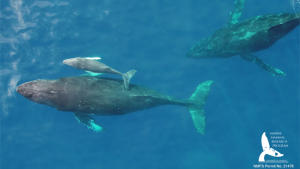Proper intake of food is essential for pregnant humpback whales to pull off the extreme physical feat of annual migration between Hawaiʻi and Alaska. Researchers at the Marine Mammal Research Program (MMRP) at University of Hawaiʻi at Mānoa Hawaiʻi Institute of Marine Biology (HIMB) revealed the energetic cost and vulnerabilities of migratory humpback mothers-to-be in a study published in The Journal of Physiology .
Humpbacks feed in polar waters and then must fast and migrate up to 5,000 km to the tropical waters where they breed and give birth. Humpback whale mothers spend about 10 months in pregnancy, averaging about 100 days a trimester. Using a variety of new and historical records of measurement on the whales they were able to determine their findings. They found that the size of mothers directly correlated to the size of the fetus—the larger the mother the larger the fetus and the larger the growth rate.

The team determined that the energy cost of the first two thirds of the pregnancy were negligible, comprising .01–1.08% of the energy used. The majority of the energy needs came in the final third of the pregnancy, when requirements ticked up to 98.2%.
Crucial 100 days of pregnancy
"It was surprising to see how the peak of energy requirements coincided with the onset of fasting in pregnant females, ultimately highlighting how crucial those final 100 days of pregnancy are for this migratory species," said Martin van Aswegen, PhD candidate and lead author of the study. "Females that are late in the pregnancy are therefore particularly vulnerable to disruptions in energy balance, given periods of greatest energetic stress coincide with fasting and migration to sub-tropical breeding grounds. Our study highlights a particularly vulnerable period for pregnant humpback whales. This is important, because once these whales leave their high-latitude feeding grounds, they have a finite amount of energy available to invest in their offspring over a 3–5 month fasting period, with energy requirements being even higher after calf birth."
A 75.6% decline in the number of humpback whale mothers with calves was seen and documented off Hawaiʻi between 2013 and 2018. In Southeast Alaska, a recent study shows calf production was approximately six times lower between 2015 and 2019 compared to pre-2015 years, with mid-summer calf mortality increasing tenfold from 2014 to 2019. Studies have reported significant and prolonged shifts in the distribution of the marine food web, resulting in poor feeding conditions for humpback whales.
"This research underpins future studies on humpback whale energy demands," said Lars Bejder, co-author of the study and director of MMRP. "Our drone-collected whale health database, developed in partnership with the Alaska Whale Foundation, includes over 11,000 measurements from 8,500 individual North Pacific whales. Its extensive temporal and spatial scale offers invaluable insights into the effects of large-scale climatic events on this iconic sentinel species. Sustaining such long-term, wide-scale studies is crucial for understanding these impacts within the context of natural variability in whale health."
"This research underscores the value of collaboration in tackling complex questions about the lives of humpback whales," said Jens Currie, co-author and chief scientist at Pacific Whale Foundation. "Through large-scale collaborations, we're able to gain critical insights into the challenges migratory whales face during pregnancy to better inform conservation strategies. Together, we can address large-scale ecological challenges that no single institution could achieve alone."
The research was done in partnership with Alaska Whale Foundation , Pacific Whale Foundation and others, and highlights key factors that will help inform future conservation.
The post Pregnant humpback whales' energy needs increase when fasting during migration first appeared on University of Hawaiʻi System News .






